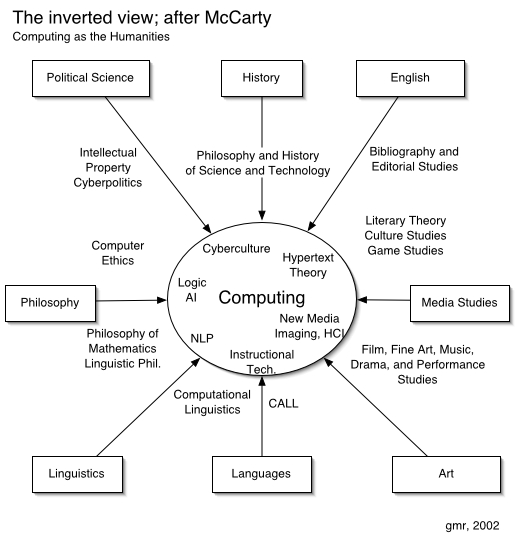CBC had a great short on the Theremin, an instrument invented in 1919 by the Russian Lev Termen (later Leo Theremin). You don’t touch the instrument, you move your hands close to antennas to produce an eerie, almost human, sound typical of early science fiction movies. According to Theremin World a revival started in the 1990s – the Theremin is back. Needless to say, I want one.
Scrolling foldout from at site on Lissitzky
I found an interesting use of HTML and Javascript while browsing this site on the Russian Futurist designer El Lissitzky (1890-1941), “Monuments of the Future”: Designs by El Lissitzky (Getty Research Institute). For the catalogue of the Soviet Pavilion’s installation at the International Press Exhibition in Cologne in 1928, Lissitzky designed an accordion foldout of photomontages. The Getty Research Institute page for this foldout lets you scroll right across the panels of the foldout.
I’m not sure about the rest of the design for the site with its use of frames, but the information and images make this a first rate research site.
An interesting feature of the site is that you can compare HTML (“Common Format”) and Flash (“Enhanced”) versions. To my mind the HTML is better; I’m not sure what is enhanced about the Flash version.
Photo Mosaics
Ever wondered how to make images out of mosaics of other images? William Hunt has a site devoted to PhotoTiled Pictures. Of interest is how Dali copied an early photo mosaic painting each tile – see the history page.
I came across this on a page on Photo Mosaic Software Information for your Digital Photos at the Design & Publishing site (www.graphic-design.com).
Games for surgeons
According to a Reuters story, Doctors Use Video Games to Hone Skills (Ben Berkowitz, Dec. 19, 2004) a Dr. Rosser of the Advanced Medical Technologies Institute says, “Surgeons who play video games three hours a week have 37 percent fewer errors and accomplish tasks 27 percent faster”. No word on whether it makes you a more moral person.
Total Knee Replacement Edutainment
Edheads – Virtual Knee Surgery – Total Knee Replacement is an excellent and revolting Flash multimedia work where you walk through the replacement of a knee and then get to see pictures. (I have knee trouble, which may be why I find this hard to take.) This is from an interesting multiauthor blog from MIT, Technology Review.
Master of Communication (M.C.) in Digital Media
The Department of Communication at the University of Washington is starting a Master of Communication in The Digital Media. It looks like it is focused on policy and legal issues, not creative issues. This link is thanks to Terry Flynn.
Continue reading Master of Communication (M.C.) in Digital Media
OECD Information Technology Outlook 2004
The Table of Contents and the Highlights PDF of the OECD Information Technology Outlook 2004 is now available. The Highlights document mentions that spam is now estimated to be about 60% of e-mail and the OECD is now coordinating a Task Force on spam (see OECD Work on Spam: Department), they have a “Toolkit” (which you can’t download!) and there are some reports online that nicely summarize things. (See OECD Work on Spam: Publications & Documents: Reports – the Background Paper in particular provides an overview of the growth in spam.) Maybe the OECD will do something about spam. This came to me from a post by Lachance on Humanist.
Computing or Humanities?
From Humanist, an essay on Computing or Humanities? The Growth and Development of Humanities Computing which mentions what is happening at King’s and Willard McCarty and Harold Short’s map of a Methodological Commons.
I tend to take a very different view where Humanities Computing is not an area of computing methods and tools useful to the humanities, but a discipline that brings humanities inquiry to and through computing. The radical idea I would put forward is that computing (or at least multimedia) is a new discipline of the humanities that draws on traditions of the more established disciplines.
Worcester Polytechnic Institute program in Game Design
Grand Text Auto has a blog entry about, Another undergraduate game program at Worcester Polytechnic Institute. Thanks to StÈfan for this.
50×15 project from AMD
Matt Patey has drawn my attention to the 50×15 Initiative by AMD to create a PIC (Personal Internet Communicator) that is low-cost and easy to use so that by 2015 we could see 50% of the world’s population connected to the Internet. For a story on this see, AMD’s PC to increase online world / Low-end Internet model would assist emerging countries.
I, like Matt, have problems with the technology choices (Windows CE in a closed box with various preinstalled apps for media viewing.) This is a recipe for expanding the base of consumers not for empowering people to participate as creators on the net. The idea, if I understand AMD’s slides, is to market this through the telecommunication companies – reminds me of Minitel.
While Linux may not be the cure for all ills, why not imagine a project like this based on a cheap Linux laptop like the Wal-Mart $500 linux laptop.
